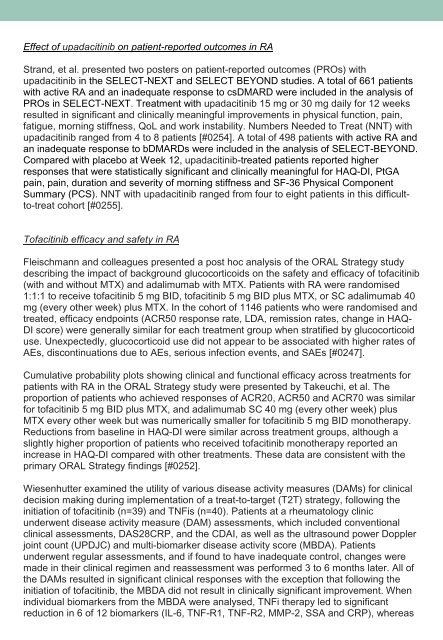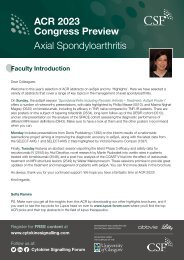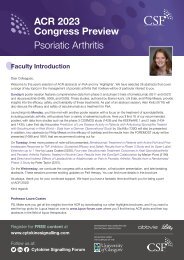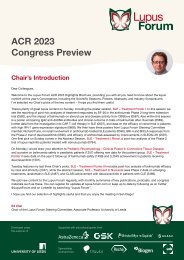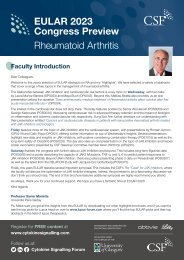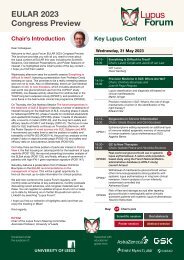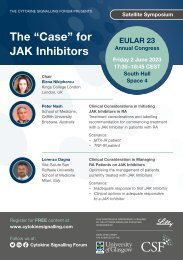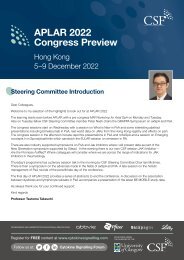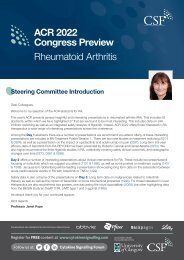EULAR 2018 Review
You also want an ePaper? Increase the reach of your titles
YUMPU automatically turns print PDFs into web optimized ePapers that Google loves.
Effect of upadacitinib on patient-reported outcomes in RA<br />
Strand, et al. presented two posters on patient-reported outcomes (PROs) with<br />
upadacitinib in the SELECT-NEXT and SELECT BEYOND studies. A total of 661 patients<br />
with active RA and an inadequate response to csDMARD were included in the analysis of<br />
PROs in SELECT-NEXT. Treatment with upadacitinib 15 mg or 30 mg daily for 12 weeks<br />
resulted in significant and clinically meaningful improvements in physical function, pain,<br />
fatigue, morning stiffness, QoL and work instability. Numbers Needed to Treat (NNT) with<br />
upadacitinib ranged from 4 to 8 patients [#0254]. A total of 498 patients with active RA and<br />
an inadequate response to bDMARDs were included in the analysis of SELECT-BEYOND.<br />
Compared with placebo at Week 12, upadacitinib-treated patients reported higher<br />
responses that were statistically significant and clinically meaningful for HAQ-DI, PtGA<br />
pain, pain, duration and severity of morning stiffness and SF-36 Physical Component<br />
Summary (PCS). NNT with upadacitinib ranged from four to eight patients in this difficultto-treat<br />
cohort [#0255].<br />
Tofacitinib efficacy and safety in RA<br />
Fleischmann and colleagues presented a post hoc analysis of the ORAL Strategy study<br />
describing the impact of background glucocorticoids on the safety and efficacy of tofacitinib<br />
(with and without MTX) and adalimumab with MTX. Patients with RA were randomised<br />
1:1:1 to receive tofacitinib 5 mg BID, tofacitinib 5 mg BID plus MTX, or SC adalimumab 40<br />
mg (every other week) plus MTX. In the cohort of 1146 patients who were randomised and<br />
treated, efficacy endpoints (ACR50 response rate, LDA, remission rates, change in HAQ-<br />
DI score) were generally similar for each treatment group when stratified by glucocorticoid<br />
use. Unexpectedly, glucocorticoid use did not appear to be associated with higher rates of<br />
AEs, discontinuations due to AEs, serious infection events, and SAEs [#0247].<br />
Cumulative probability plots showing clinical and functional efficacy across treatments for<br />
patients with RA in the ORAL Strategy study were presented by Takeuchi, et al. The<br />
proportion of patients who achieved responses of ACR20, ACR50 and ACR70 was similar<br />
for tofacitinib 5 mg BID plus MTX, and adalimumab SC 40 mg (every other week) plus<br />
MTX every other week but was numerically smaller for tofacitinib 5 mg BID monotherapy.<br />
Reductions from baseline in HAQ-DI were similar across treatment groups, although a<br />
slightly higher proportion of patients who received tofacitinib monotherapy reported an<br />
increase in HAQ-DI compared with other treatments. These data are consistent with the<br />
primary ORAL Strategy findings [#0252].<br />
Wiesenhutter examined the utility of various disease activity measures (DAMs) for clinical<br />
decision making during implementation of a treat-to-target (T2T) strategy, following the<br />
initiation of tofacitinib (n=39) and TNFis (n=40). Patients at a rheumatology clinic<br />
underwent disease activity measure (DAM) assessments, which included conventional<br />
clinical assessments, DAS28CRP, and the CDAI, as well as the ultrasound power Doppler<br />
joint count (UPDJC) and multi-biomarker disease activity score (MBDA). Patients<br />
underwent regular assessments, and if found to have inadequate control, changes were<br />
made in their clinical regimen and reassessment was performed 3 to 6 months later. All of<br />
the DAMs resulted in significant clinical responses with the exception that following the<br />
initiation of tofacitinib, the MBDA did not result in clinically significant improvement. When<br />
individual biomarkers from the MBDA were analysed, TNFi therapy led to significant<br />
reduction in 6 of 12 biomarkers (IL-6, TNF-R1, TNF-R2, MMP-2, SSA and CRP), whereas


